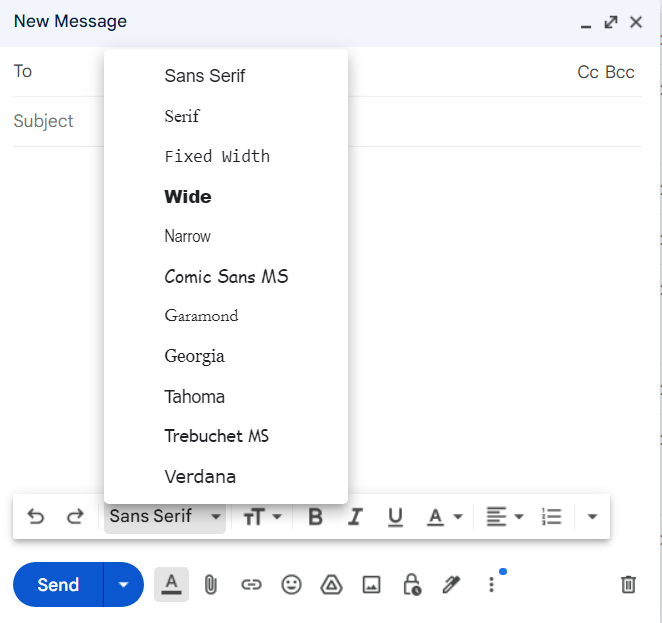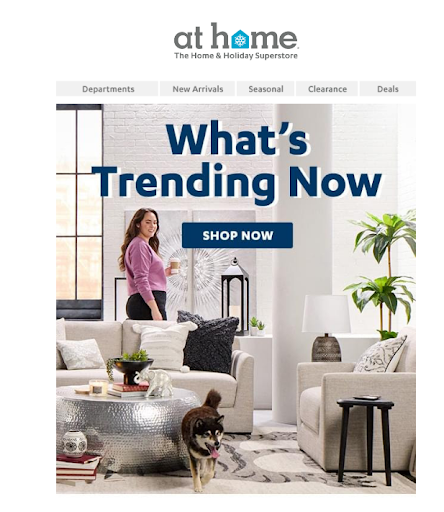
The early days of the Internet were a time of questionable design choices. It was normal to stumble across random web pages with ten different fonts and clashing colors. Many emails had flashing text, animated GIFs, and even background music. And who can forget Microsoft’s over-the-top WordArt? It was, in short, pure sensory chaos.
Luckily, web design has come a long way in the last twenty years. Today’s web pages and emails look more polished and professional than early versions. But choosing design elements carefully is still essential — especially if you’re representing a brand.
Font is one of the most crucial parts of digital communication. According to Statista, people spend an average of ten seconds reading a brand email. The best email font makes it easy for readers to find and remember key information. But an unreadable font will leave your audience frustrated, confused, and uninterested.
Our tips will help you choose the best email fonts for your email marketing campaigns. We break down the different font families, factors to consider when choosing a font, and more.
Understanding email fonts
Most people recognize popular fonts like Arial and Times New Roman. But there are many more options available. Whatfontis.com estimates that designers have created over 990,000 fonts. Understanding the main types of fonts and their significance can help you narrow your options.
System fonts vs. web fonts vs. custom fonts
There are three main categories of fonts: system (or web-safe), web, and custom.
A system font is a typeface that comes pre-installed on all major operating systems. Linux, macOS, and Windows users can view these fonts on their devices. These fonts also load instantly. However, they offer less creative freedom than other options. Examples of systems fonts include Arial, Courier New, and Verdana.
A web font is a typeface designed specifically for the Internet. These fonts are hosted on external servers, not the user’s device. They take longer to load than system fonts and may not display correctly for every reader. Examples of web fonts include Lato, Open Sans, and Roboto.
You can also design custom fonts or buy them from a third-party creator. This option lets you pick a unique font that fits your brand identity. However, custom fonts may not be compatible with all devices and may have licensing requirements.
The importance of font for email marketing
Choosing a font involves more than picking a style that looks nice. Choose a font that fits your brand voice and the tone of your email. A bold, heavy font may seem aggressive or confident. A slim, clean font appears formal and sophisticated. And a shaky font may look like a child’s messy handwriting.
The font also affects how readers engage with your emails. A simple, easy-to-read font makes your messages more accessible for people with disabilities. By contrast, tiny and cramped text can make your emails unreadable. Some fonts also load faster than others, improving the user experience.
Traits of a good email font
Font style is often a matter of personal taste. But some fonts work better for email communication than others. Generally, the best email fonts have these characteristics:
- Easy to read at all sizes and from different distances
- Compatible with major platforms and devices
- Clean and minimalistic appearance
- Adequate whitespace between letters
- Letters look consistent in style
- Appropriate for the tone of your message
Email font families
There are three main “families” – or styles – of font: serif, sans-serif, and decorative.
Serif fonts
Serif fonts have small, decorative lines or “feet” at the ends of the letters. These flourishes are called serifs, and they make writing look classy and formal. Serif fonts are often used for professional communication and printed materials. For example, many books and newspapers use serif fonts.
Popular serif fonts include:
- Book Antiqua
- Garamond
- Georgia
- Times New Roman
Sans-serif fonts
As the name suggests, sans-serif fonts are sans – or without – serifs. The letters don’t have decorative tails or flourishes. Instead, each letter has simple, straight lines. Sans-serif fonts are easy to read on a computer or phone screen. Web designers often use these styles for digital materials, such as emails and web pages.
Common sans-serif fonts include:
- Arial
- Calibri
- Helvetica
- Open Sans
Decorative fonts
Decorative fonts have more artistic and unique designs than standard fonts. These traits make these fonts eye-catching but can be difficult to read in large chunks. They’re also not web-safe and may be inaccessible for some readers.
As a result, designers tend to use decorative fonts in small doses. They often appear in logos, headlines, or special sections of text.
Popular decorative fonts include:
- Copperplate Gothic
- Lobster
- Pacifico
- Zapfino
Choosing your email font
The font affects how readers view your brand and message. A legible and professional font will make a positive impression on your readers. On the other hand, a sloppy or unappealing font makes it less likely that people will read your email.
Here are four considerations to help you pick the best font for business email and other types of messages.
Accessibility
According to the Centers for Disease Control and Prevention, over seven million Americans have vision impairments. Many of these people rely on screen readers and other assistive devices to read emails. Others may use reading glasses or zoom in on the text to read it.
Choosing accessible fonts makes your emails more inclusive. Look for simple sans-serif typefaces with clean, easy-to-read letters. Thick fonts are also easier to read than thin styles.
Avoid decorative and serif fonts with unnecessary flourishes. You also shouldn’t use cursive fonts or blinking text. These styles may look fancy, but they’re more challenging for readers to interpret.
Tone
Your brand has a unique voice, and your fonts should reflect it. Each font style evokes different emotions and tones, so finding the right fit for your brand personality is important.
Designers often use serif fonts for professional and formal communication. These fonts look elegant, sophisticated, and traditional. They also have a more authoritative and timeline tone.
Sans-serif fonts look clean and modern. They’re associated with efficiency and clarity. They typically help to deliver a no-nonsense tone, so they’re helpful for straightforward messages.
Decorative fonts can convey a broad range of emotions and tones. Some decorative fonts look friendly, light-hearted, and playful. Others may seem stern or unwelcoming.
Cross-platform compatibility
Readers use various devices and platforms to check their email. Some people may read your messages on their iPhones, while others will open them on their Windows PCs. Choosing a font with cross-platform compatibility ensures that your emails look the same for all users.
All major platforms support web-safe fonts, such as Book Antiqua, Trebuchet MS, and Times New Roman. These fonts are the safest options for emailing clients.
Font size
Font size also affects how readers engage with your text. The best font size for email is 12 to 16 points.
Pick a font that looks attractive and readable in this range. These sizes make your text accessible to most readers on different devices. Users may struggle to read smaller text, and larger sizes may have strange formatting on smartphones.
Popular fonts for email
Here are the top 10 recommended fonts for emails in alphabetical order. Any of these styles will suit most email marketing campaigns.
- Arial: A contemporary and clean sans-serif font
- Courier New: A serif font that resembles typewriter text
- Futura: A stylish font with geometric-shaped letters
- Georgia: A classic and formal serif font often used for dense text
- Helvetica: A stylish sans-serif font with close lettering
- Palotino: A slender serif font often used for headings
- Tahoma: A thick sans-serif font that stands out
- Times New Roman: A popular serif font often used for academic text
- Trebuchet MS: A narrow sans-serif font
- Verdana: A bold, wide sans-serif font
Email-friendly fonts for specific use cases
Some circumstances call for the use of specific fonts.
Email signatures
Professionals often include signatures at the bottom of their emails. The best font for an email signature is a decorative but legible style that fits your personality. Popular print fonts include Arial, Lucida, and Palatino.
The best cursive font for email signatures is a script font that resembles handwritten text, such as Autograf or Pacifico.
Email newsletters
It’s best to use a web-safe font like Helvetica or Verdana for email newsletters. These fonts are compatible with all email providers and load quickly.
Gmail fonts

Gmail only allows users to choose from a handful of fonts, including Comic Sans MS, Garamond, and Verdana. These fonts are all accessible and legible, so you can pick whichever option best fits your brand voice.
Fonts to avoid in emails
Many people consider these fonts unattractive or unprofessional:
- Comic sans: Dated and often mocked in Internet memes
- Curlz: Has curly letters that look childish
- Papyrus: One of the most overused fonts
You should also avoid elaborate or quirky fonts that may be difficult to read.
Optimizing your email fonts
These best practices can help you use email fonts effectively:
- Use a simple email template to organize your content.
- Avoid using more than two or three fonts per email.
- Adjust line and letter spacing if necessary to increase readability.
- Stick to 12 to 16-point fonts.
- Consider less popular web-safe fonts, such as Common Gothic or Garamond.
- Test your email on different devices before you send it to make sure the font displays properly.
- Use A/B testing to see which fonts perform best.
Email font customization

Some marketers choose to use custom HTML email fonts. These fonts can make your emails look distinct and increase engagement. However, email clients like Gmail and Outlook typically can’t render custom fonts. Instead, they may convert the text to a web-safe font. Always test custom fonts across email clients before using them.
Different font colors and alignments can make any font style feel more unique. Pick high-contrast colors to increase accessibility, and use alignments to organize content in a hierarchy.
Additionally, a distinct font can help the reader spot call-to-action buttons. Consider using bolded or heavier text for these buttons. A different font color will also make these buttons stand out.
Additional considerations for email fonts
Follow these bonus tips when using email fonts in business and marketing settings:
- Proofread content thoroughly to catch grammar and spelling mistakes.
- Choose fonts that look authoritative and credible if you want readers to click hyperlinks.
- Most email clients don’t allow you to choose the font for subject lines or email addresses. But you should choose a bold font if possible to help your message stand out.
- Consider adjusting fonts for mobile readers to make the text easier to read on small screens.
- Segment your email list to use different fonts for certain groups of contacts.
Software tools and resources
Choosing an email font can feel overwhelming, but there are many resources to help you find the right fit.
These handy frameworks streamline the design process. You can use the suggested fonts or customize the templates with your favorite styles. The templates adjust automatically to different devices and platforms for the best user experience. Their email tracking also makes it a strong marketing tool to use for communicating with your audience.
Whatfontis.com can identify almost a million fonts from an image. This tool lets you research fonts you like and discover similar styles.
Additionally, spell check and grammar software makes it easier to write error-free emails. Popular platforms like Grammarly and ProWritingAid have free and paid plans.
Dazzle your readers with your visual design skills
Businesses often put a lot of effort into crafting the perfect text. But how you display your message is often just as important as what you say. Choosing a stylish font that reflects your brand identity will help you connect with your audience. The right font can also establish your credibility and set the tone of your message.
Decorative fonts will likely become more popular in the future as designers invent new styles. But accessibility remains key. It’s best to pick simple and recognizable fonts that all contacts can read. That way, you can extend your reach and make your content as inclusive as possible.




